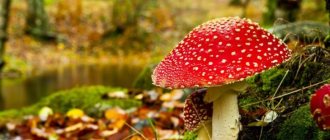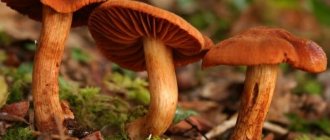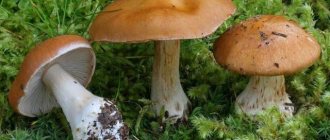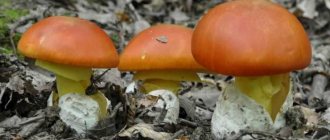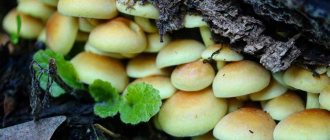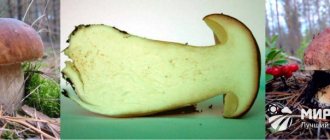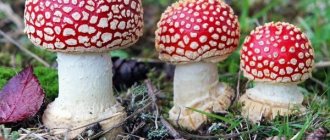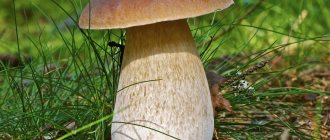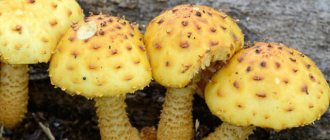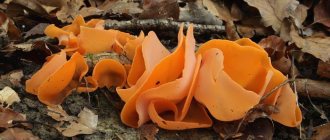The brick-red honey fungus is considered inedible. Despite the fact that the mushroom is part of the inedible group, some mushroom pickers collect it. Daredevils risk eating the mushroom after boiling and soaking, but its pulp does not have a distinct taste and aroma. It’s not worth risking upset or poisoning of the gastrointestinal tract for brick-red honey mushrooms. Another name for the mushroom is false foam, in Latin Hypholoma sublatertium. These are small mushrooms that grow in large colonies and usually appear on stumps and other dead wood. In some countries of Southeast Asia, they are grown artificially on a substrate of sawdust and other materials and are used in alternative medicine.
The main difference between this honey mushroom is the color of its cap. It has a brick-red color, which gives the mushrooms their name. With a diameter of about 2-10 cm. This species loves warm latitudes and chooses coniferous or mixed forests. This article will discuss all the features of this mushroom and how not to confuse it with the edible species of honey mushrooms.
What is brick-red honey fungus?
What does brick-red honey fungus look like?
The brick-red honey fungus has the following description. Brick-red honey fungus is also called summer honey fungus. This fungus, like its relative, parasitizes wood. But for this mushroom, dead wood and stumps are more preferable. You can also find the mushroom on wooden human creations: fences, bridges. This mushroom lends itself well to cultivation.
Other names for the mushroom:
- Hyfoloma brick-red;
- False honey fungus brick-red;
- Hypholoma sublateritium;
- Agaricus carneolus;
- Nematoloma sublateritium;
- Inocybe corcontica.
Many countries around the world are engaged in its cultivation under artificial conditions. Moreover, the wood, after the fruiting of this mushroom, acquires greater strength and wear resistance. The diameter of the cap reaches 10 cm. It is divided by color into concentric zones from light brown to ocher. With age, the plates of the mushroom begin to darken and take on the color of the cap, although initially they are white.
hat
The young mushroom is dome-shaped, hemispherical. As it grows, it becomes cone-shaped and spread out. The cap is fleshy and dense. The color of the cap is brownish-yellow, red-yellow, darker in the center than the rest of the area. The edges are lighter in comparison with the main color, often with spots. The surface of the cap is covered with flake-like scales of a yellowish-white color.
Cap pulp
White with a yellow tint, unpleasant smell, bitter taste. Along the edge of the cap, the remains of a membranous blanket covering the spore-bearing layer are visible.
Hymenophore
(bottom of cap) lamellar. The plates are frequent, narrow, adherent to the stem. At first they are white-yellowish, then yellow-brown, and with age they become gray-brown from maturing spores.
Spore powder
Dark brown, with a purple tint.
Records
Frequent, attached to the stem, in young individuals white with a yellowish tint, over time they become yellow-brown. In old mushrooms, maturing spores cause the plates to acquire a gray-brown tint.
Stipe
Grows up to 10 cm in height, hollow in structure. This variety of mushrooms prefers deciduous or coniferous trees and warm climatic conditions. Under the right greenhouse conditions, they will bear fruit several times in one season. As for cooking, the mushroom is a delicacy and has a wonderful taste, both boiled and fried, but is classified in the section of inedible mushrooms.
Expert commentary
Anastasia Rodionova
Biologist by training and an avid mushroom picker
Ask a Question
The ring (the so-called “skirt”) on the leg: is clearly absent, but if you look closely, in the “ring zone” of some adult specimens you can see the remains of “threads” from the private coverlet.
Recipes
Despite the fact that this mushroom is classified as conditionally edible, you can find a huge number of recipes with this mushroom on the Internet. But before studying them, it is important to understand one main thing. To ensure that the mushroom does not harm your health and the health of your loved ones, it must be properly prepared.
Preparation includes the following steps.
- Free mushrooms from forest debris. To do this, you need to remove needles, leaves, clods of earth and insects.
- Place the mushrooms in a colander and rinse under cold running water.
- Fill a large saucepan with the required amount of water and add the mushrooms there. Bring to a boil and leave to simmer for 15-20 minutes.
- Turn off the pan, mushrooms and rinse under cold water.
- Then repeat this procedure two more times, each time maintaining a boiling time of 15-20 minutes.
- Cool the mushrooms.
- If the cap begins to come off in flakes, help it and peel the skin with a knife.
Done, now you can start cooking.
Chemical composition of the mushroom
Honey mushrooms contain a high water content (up to 90% on average), which ensures their low calorie content. The remaining 10% comes from proteins (4%), fiber (2%), minerals (1.5%), carbohydrates (1.5%) and fats (1%). The nutritional value of the mushroom - per 100 g of product in grams - is as follows:
- dietary fiber – 5.1;
- proteins – 2.2;
- fats – 1.2;
- carbohydrates – 0.5;
- disaccharides and monosaccharides – 0.5;
- ash – 0.5.
The chemical composition of honey mushrooms includes essential amino acids and organic acids, antioxidants, and microelements. Among them:
- vitamins A, B, C, E;
- potassium – 400 mg per 100 g;
- iron;
- magnesium;
- calcium;
- phosphorus;
- sodium and others.
Differences from edible mushrooms
The brick-red false honey fungus differs from the ordinary honey mushroom in the following characteristics:
- Bright and rich brown color.
- A barely noticeable trace of the belt on the leg.
- Unpleasant smell of pulp.
| Group: | Lamellar |
| Records: | Yellowish-brown, brownish-brown, yellowish-white |
| Color: | Brownish yellow, red yellow |
| Peculiarities: | The center of the cap is darker than the edges |
| Department: | Basidiomycota (Basidiomycetes) |
| Sub-department: | Agaricomycotina (Agaricomycetes) |
| Class: | Agaricomycetes (Agaricomycetes) |
| Subclass: | Agaricomycetidae (Agaricomycetes) |
| Order: | Agaricales (Agaric or Lamellar) |
| Family: | Strophariaceae (Strophariaceae) |
| Genus: | Hypholoma (Hypholoma) |
| View: | Hypholoma lateritium (Brick red honey fungus) |
Candoll's false honey fungus (with photo)
Candoll's false honey fungus is edible, its cap is 3-6 cm in diameter, thin-fleshy, finely scaly, first hemispherical, strongly convex, then open, flesh-yellow or woody yellow, then whitish.
Scales in the form of scraps of white threads. In wet weather the cap is very sticky and slimy. The plates are narrow, adherent, white, then pinkish and, finally, brownish-purple flesh-colored. The leg is white, tubular, silky-fibrous, 5-8 cm long, 3-5 mm thick. Spore powder is brown. Look at this false honey fungus in the photo, which will help you successfully identify it during a “silent hunt”:
Candoll's false honey fungus grows in deciduous and mixed forests
Candoll's false honey fungus in the photo
Fruits from July to October in groups and singly.
It is similar to the inedible Psatirella artemisiae, which is distinguished by small caps up to 1.5 cm and the smell of wormwood.
After boiling for 5 minutes, it becomes less brittle and ready to use in cooking.
Similar species
The sulfur-yellow false honey fungus is a close poisonous relative of the brick-red false honey fungus. The diameter of the cap is 2-7 centimeters. In young specimens, the cap is first bell-shaped, then becomes prostrate. The color of the cap is sulfur-yellow, brown-yellow, yellowish. There is a darker stripe in the center, and a lighter color along the edge. The length of the leg reaches 10 centimeters with a width of 0.3-0.5 centimeters. The leg is hollow inside, smooth, light yellow in color.
Sulfur-yellow false fungus is a poisonous mushroom, which 6 hours after entering the stomach is accompanied by nausea, excessive sweating, severe vomiting and loss of consciousness.
Galerina carinatum is a poisonous mushroom. The diameter of the cap is 1.7-4 centimeters. The color of the cap is brown or yellow-brown. Older specimens have flatter caps and darker legs and plates. The membrane ring is clearly visible on the stem of young mushrooms, but with age it disappears.
These mushrooms are widespread in Europe, Asia and North America, and they are also found in Australia. Galerina fringe is a wood-destroying fungus and most often lives on coniferous trees, although it is sometimes found on deciduous trees. These mushrooms are extremely poisonous, containing the same deadly toxins as toadstools. In case of poisoning with a large number of mushrooms, severe liver damage occurs; in the absence of prompt treatment, death is possible.
Appearance and structure
The brick-red false honey fungus is similar in appearance to the common honey fungus, but has a more saturated and bright color of the cap, and there is no characteristic belt on its stem. An important distinguishing feature is the presence of an unpleasant smell of pulp in the false honey fungus.
In 1871, the German mycologist Jacob Christian Schäfer first described the brick-red honey fungus.
The mushroom cap at a young age has a spherical shape, and as it grows it opens up like an umbrella. In addition, the bright color of the mushroom becomes more saturated closer to the center of the cap. When broken, the flesh is quite dense and dirty yellow in color. The leg of the false honey fungus is fibrous and smooth, reaching up to 10 cm.
We recommend that you read our electronic magazine about growing mushrooms at home.
Can it be eaten?
Scientists do not have a consensus on the edibility of brick-red false honey mushrooms. These mushrooms are considered edible in Germany, Italy and Canada, but in our country they are poisonous, so mushroom pickers avoid them.
But not all over Russia treat brick-red false honey mushrooms with such danger. For example, in Chuvashia, local residents collect these mushrooms and consider them quite edible. Every year people die from mushroom poisoning, but most often doctors determine only the poison, and not the name of the mushroom, so it is impossible to say that cases of poisoning occur specifically from brick-red false mushrooms, but this possibility cannot be denied.
It is known that false honey contains toxins that cause stomach upset. Poisoning with false honey mushrooms causes stomach pain, vomiting and headache.
If you eat honey mushrooms for several years, then immunity to toxins is formed, in this case poisoning does not occur. But, still, you should not risk your health and experiment with these mushrooms.
Taste assessment, primary processing and preparation
In many domestic sources you can find information that this type of mushroom should not be eaten.
There is also an opinion that brick-red honey fungus is a conditionally edible species. But in Europe and Japan, this mushroom is bred on an industrial scale, claiming that brick-red false honey fungus is quite edible. The same idea is confirmed by mushroom pickers, who many times prepared delicious dishes from false foam.
To prepare Hypholoma sublateritium, you need to wash the fruiting bodies and boil them for 20 minutes in salted water. Then drain the water, add fresh water and boil again for the same period of time. At the last stage, the fruits are placed in a colander, the liquid is allowed to drain and prepared in accordance with the recipe: pickled, salted, fried.
Why is brick-red false honey fungus dangerous?
First of all, pay attention to the appearance of a single mushroom. In addition to the bright orange color of the cap, which in adult individuals takes on a brick-red hue, attention is drawn to scraps of the white covering. It remains in large flakes on the edges of the cap, which is covered with a kind of fringe. The second distinctive feature is the absence of a tight ring on the stem. This element is considered mandatory for real autumn honey fungus, which is suitable for consumption.
It is believed that honey mushrooms contain toxins that cause stomach upset. Poisoning with red-brown honey mushrooms is accompanied by the following symptoms:
- nausea;
- vomit;
- stomach ache;
- headache;
- dizziness.
Most often, false mushrooms cause damage to the central nervous system. This may include mild forms of dizziness, headaches, nausea and vomiting. With more serious damage, increased heart rate, increased blood pressure, and nosebleeds are possible.
Without timely medical care, a person can fall into a coma and die from cardiac arrest or dislocation of hemispheric structures due to hemorrhage in the brain stem.
Continuing the description of the brick-red honey fungus, we should add that as it grows, its rounded cap takes the shape of a saucer with a diameter of up to 5 cm. A thin long leg with a diameter of up to 1.5 cm.
Contraindications
And, of course, it is important to take into account the contraindications that brick-red false foam has. It is not recommended to eat the mushroom if you have the following diseases, especially in the acute stage:
- stomach,
- liver and gallbladder,
- kidney,
- intestines.
You should also refrain from eating this mushroom if you have a weak, sensitive gastrointestinal tract.
In addition, dishes made from brick-red false foam are prohibited:
- if you are allergic to mushrooms,
- children under 7 years old,
- during pregnancy,
- during lactation.
Important! The information presented in the material is for informational purposes only. Before use, be sure to consult a specialist.
Literature:
T.A. Ilyina. Mushrooms. Atlas-determinant.
M.V. Vishnevsky. Mushrooms. Key to mushrooms of Russian forests and fields.
Lagutina T.V. The complete encyclopedia of mushrooms.
Mikhail Vishnevsky. Medicinal mushrooms. Great encyclopedia.
Yu.I. Smirnyakov, A.K. Koshcheev. Mushroom picker's companion.
A.P. Umeltsev. Encyclopedia of mushroom picker.
Where and how does it grow
Brick-red false honey fungus grows everywhere - its range extends to the central regions of Russia, the Far East, the Urals, and Siberia. It also grows in Europe and North America. Prefers mixed or deciduous forests, roots of fallen trees - birch, alder or aspen; stumps covered with moss. It is rarely found alone; it grows in large groups, even colonies. Its active growth begins in August and continues throughout the fall, until the onset of cold weather.
Brick-red representatives of the Strophariidae do not grow on coniferous trees. Most often they can be found in late autumn on old fallen logs and stumps of deciduous trees, especially in places where they have rotted. In productive years, brick-red honey fungus grows on wooden fences or other wood products.
Another sign of false mushrooms is the growing area and the choice of wood species for parasitism. This type of poisonous honey mushroom prefers light, well-ventilated deciduous forests for its growth. They grow exclusively on fallen trunks and stumps left over from deciduous trees. Most often these are linden, aspen, birch, and alder. This species of false mushrooms is not found on coniferous trees.
Interesting facts about honey mushrooms
- All varieties of honey mushrooms are hard workers: usually settling on diseased or almost completely non-viable wood remains and overly depleted soils, these mushrooms perfectly process any biomass into useful microelements, restore the balance of the soil substrate, making it suitable and healthy for the growth of other plants.
- In Rus', the skin of the meadow mushroom was used on the principle of a modern adhesive plaster: it perfectly healed shallow wounds from cuts, relieved the burning sensation after burns and relieved pain.
- In ancient times, the mushroom mushroom was credited with the magical property of indicating a treasure: it was believed that where there are many honey mushrooms, there must be a buried treasure.
Fruiting time
Brick-red honey fungus is found already in July. The period of mass fruiting of this mushroom occurs at the end of August and September. Single mushrooms can be found until the first frost. The fruiting period of brick-red honey fungus depends on weather conditions. Moreover, the harvest will be much larger if the autumn is warm and rainy. Mushrooms do not grow well in dry weather. The mushroom usually appears in August and grows until lasting frosts. Fruiting time occurs at the end of August and beginning of September.
How to distinguish honey mushrooms.
Edible or toxic
Information about the edibility of red honey fungus with a brick tint is contradictory, so it is considered a conditionally edible mushroom . False honey fungus can easily be confused with ordinary edible honey fungus, since after boiling the bitter taste of the mushroom disappears and a pleasant mushroom aroma appears.
In countries such as Germany, Canada and Italy, brick-red honey fungus is classified as an edible mushroom. Still, most mycologists consider the mushroom to be mildly poisonous and recommend avoiding it.
The optimal temperature for the growth of brick-red honey fungus is an air temperature of +15...+20°C and a humidity of 100%.
How to distinguish a false honey mushroom from a real one
False honey mushrooms include several types of mushrooms that are very similar to edible honey mushrooms. In addition, they are easy to confuse, because false honey mushrooms like to grow in the same places as edible ones - they grow in families on stumps, fallen trees, on trunks and protruding parts of tree roots. Some types of false mushrooms are inedible, others are conditionally edible, and others are poisonous.
However, a mushroom picker, especially a beginner, should not experiment and should never forget the main rule: “If you’re not sure, don’t take it!” Collect only real honey mushrooms when you are absolutely sure that it is they! If you have the slightest doubt, it is better to abandon the idea of putting the mushroom in the basket. The most important sign by which you can distinguish a real honey mushroom from a false one is the membranous ring (skirt) on the leg. This ring is a remnant of the covering that protects the fruiting body of the mushroom at a young age. False mushrooms do not have such a ring. They even came up with a poem for children to better remember this main difference between edible mushrooms.
There are other differences too.
- The smell of edible honey mushrooms is a pleasant mushroom, while false honey mushrooms emit an unpleasant earthy smell.
- The caps of inedible honey mushrooms are more brightly and loudly colored than those of edible ones. The tone can vary from sulfur yellow to brick red (depending on the species). Edible honey mushrooms have a modest, dull light brown color.
- Edible honey mushrooms have a cap covered with small scales, while false honey mushrooms have no scales on the cap - it is usually smooth. But you need to remember that edible honey mushrooms at age also no longer have scales on their caps (see photo of old honey mushrooms above).
- There are also differences in the color of the plates (on the back of the mushroom cap). The plates of false mushrooms are yellow, those of old ones are greenish or olive-black, while those of edible mushrooms are cream or yellowish-white.
- They note the bitter taste of false honey mushrooms, which edible honey mushrooms do not have, but it is not worth getting to the point of assessing the taste - and without it there are enough signs by which you can distinguish an edible honey mushroom from a false one.
How brick-red honey mushrooms grow.
Dangerous false doubles
The brick-red honey fungus has quite a lot of doubles: both edible and poisonous. You can see them in more detail in the photo or in the table:
| Species name | Differences | Places and times of growth | Edibility |
| Summer honey fungus | It has a pale sulfur color on the cap and a brownish tint in the middle. It completely lacks a special fringe-like rim on the leg. The pulp has a pronounced bitter taste and a rather unpleasant odor. | Temperate deciduous and mixed forests. Grows in April - November. | Edible |
| Seroplate false honey fungus | Whitish-yellowish and then bluish-gray plates, yellow-orange, reddish-brown cap with age, pale yellow flesh with a pleasant odor. | A typical tree mushroom that grows on stumps and roots. Prefers only coniferous forests. Fruiting time is spring - autumn. | Edible |
| False honey fungus sulfur-yellow | The cap of young fruits is convex with a small tubercle in the center and the edges curved inwards; in mature ones it is flat-convex or spread out, yellowish-brown along the edges, with a reddish tint in the center. The pulp is thin, sulfur-yellow in color, darker in the stem, with an unpleasant odor and a very bitter taste. | Grows on dying wood, on stumps in deciduous and coniferous forests of Europe and Central Russia. The fruiting period lasts from April to November. | Poisonous |
| Galerina bordered | There is a clearly defined membranous ring on the stem of young specimens, with a border around the edge of the cap. | Prefers only deciduous forests | Yadovita |
Important! Experienced lovers of quiet hunting claim that you can distinguish between false and edible honey mushrooms by smell: the former have an unpleasant aroma.
Why are brick mushrooms useful?
In Japan, red honey fungus with a brick tint has long been successfully cultivated on an industrial scale and is called kuritake. When young, it is difficult to confuse it with other mushrooms, which is extremely useful in practical terms. Beneficial properties of brick-red honey mushrooms:
- general strengthening of the body;
- increasing immunity;
- normalization of metabolism;
- lowering blood pressure levels;
- calming effect on the nervous system;
- anti-inflammatory properties;
- removing bad cholesterol;
- improving performance.
Representatives of oriental medicine believe that honey fungus is capable of inhibiting the growth of malignant tumors. Traditional medicine says that with regular use, a person’s immune system resistance increases, blood cholesterol levels decrease and liver cells are restored. During prolonged cooking, false honey fungus loses its toxic properties. Despite this, you should not take risks and endanger your health by eating these mushrooms.
Use for cosmetic purposes
Representatives of oriental medicine value this type of mushroom for its ability to inhibit the growth of tumors and malignant neoplasms.
In addition, brick-red honey mushrooms have the property of increasing immunity, increasing potency, lowering cholesterol levels in the blood, and restoring liver cells. In cosmetology, mushroom extract is used as a means to rejuvenate and nourish the skin.
Video reviews
A selection of videos with descriptions and recipes for preparing mushrooms
Mushrooms of Ukraine, Mushroom experts of the Russian Federation TV
Growing at home and in the country
This mushroom has long been successfully cultivated on an industrial scale in Japan, where it received its name “kuritake.” Local housewives first boil it, then prepare all kinds of dishes, including pickled ones. It is quite possible to grow mushrooms in the country. There are several ways: on the stumps of felled trees, in a greenhouse, in jars. The most optimal and less expensive method is to cultivate deciduous trees on stumps: birch, poplar, apple, and pear.
Growing process:
- Mushroom mycelium should be introduced into holes made in the wood (1–2 cm deep).
- Cover the area with moss.
- To stimulate the growth of fruiting bodies, the blanks are sent to a basement with a constant temperature of +15–20 ºС and covered with straw.
- As soon as the stumps are overgrown with mycelium, you need to take them out to the site and dig them in.
- Next year you can already get a harvest of honey mushrooms, and they will grow until the log falls apart.
If the mycelium has been colonized in growing stumps, then the ground around them should be periodically watered. If you use felled logs, they must first be soaked in water for several days and only after that the mycelium should be populated.
Brick-red honey mushrooms can be grown at home, but for this you will need to properly prepare the nutrient substrate:
- Mix seed husks or small sawdust with small wood shavings in a 2:1 ratio in a deep container.
- The mixture must be boiled, then thoroughly drained in a colander.
- As soon as it cools, add nutritional supplements: starch, oatmeal and corn flour at the rate of 8 g of starch and 25 g of each of the two types of flour per 1 kg of sawdust.
- The resulting substrate is placed in one- and three-liter jars and compacted.
- Containers must be sterilized for 2 hours and cooled.
- It is necessary to make holes 5–7 cm deep in the substrate and add mycelium.
Containers are stored in a damp, dark room with a constant temperature of +24 ºС. As soon as the fruiting bodies begin to germinate, the mycelium should be moved to a cooler place with a temperature of +14-+16 ºС. To make harvesting convenient, place a paper bag over the neck of the jar.
What to do if you still confuse the mushrooms
After the “quiet hunt” you need to sort out the mushrooms. An experienced mushroom picker or mycologist will be able to distinguish a good mushroom from a bad one by external signs. Of course, it cannot be said that all doubles of the described mushroom are not suitable for consumption. For example, the gray-plated and red-brick species are considered conditionally edible, and the term “false” in this case implies the presence of lower taste indicators.
The procedure for sorting fruiting bodies involves the following steps:
- if in doubt, it is recommended to dispose of the product;
- if it is possible to contact a specialist, you must use his services;
- mushrooms with a putrid or pronounced unpleasant odor are inedible;
- if, when broken, the flesh becomes red in color, then it is better to throw away this mushroom;
You can also check using some popular methods. The most common:
- Cooking mushrooms with silver (spoon, coin, etc.). A darkened product is a sign of the influence of toxic substances.
- Heat treatment of mushrooms with the addition of onions and garlic, which turn brown under the influence of toxins.
- Boiling in vinegar-salt solution. The result is disinfection of mushrooms.
Benefits and harms for humans
As mentioned earlier, the red trellis is a poisonous mushroom. Therefore, it cannot be considered as a food source or medicinal material. Moreover, if possible, it is better to avoid contact with this representative of the plant world.
Particular care should be taken to ensure that children do not play with it. After all, even a small dose of its toxins can lead to food poisoning. And although death is extremely rare, it is still better to protect yourself from possible problems.
As for the benefits, in recent years the red trellis has been quite often used as part of landscape decorations. Its extraordinary appearance and bright color allow you to create an amazing range of contrasts, even on the smallest lawns. In such conditions, mushrooms live no more than one year, which is why they have to be replanted regularly.
Red grille: description
This type of mushroom is very difficult to confuse with anything else. And this is very pleasing, since the red trellis is poisonous. Therefore, you can look at it as much as you like, but scientists strongly do not recommend picking it up.
So, in appearance the mushroom resembles a mesh ball, sometimes slightly oval in shape. The first thing that catches your eye is its bright scarlet color, which is difficult not to notice even in the densest thickets. Closer to winter, the red trellis dulls and becomes more faded.
It is curious that at an early stage of development this mushroom does not yet have holes in its body. It sprouts from the ground in one solid formation, which somewhat resembles a grayish egg. After several weeks of ripening, the cocoon breaks and the mushroom itself comes out.
Initially, the sprouts rush upward, but then, under the weight of their own weight, they bend down, thereby forming a kind of sphere. A little later, pores appear on their surface, which become larger and larger every day, until the mushroom turns into some kind of lattice.
